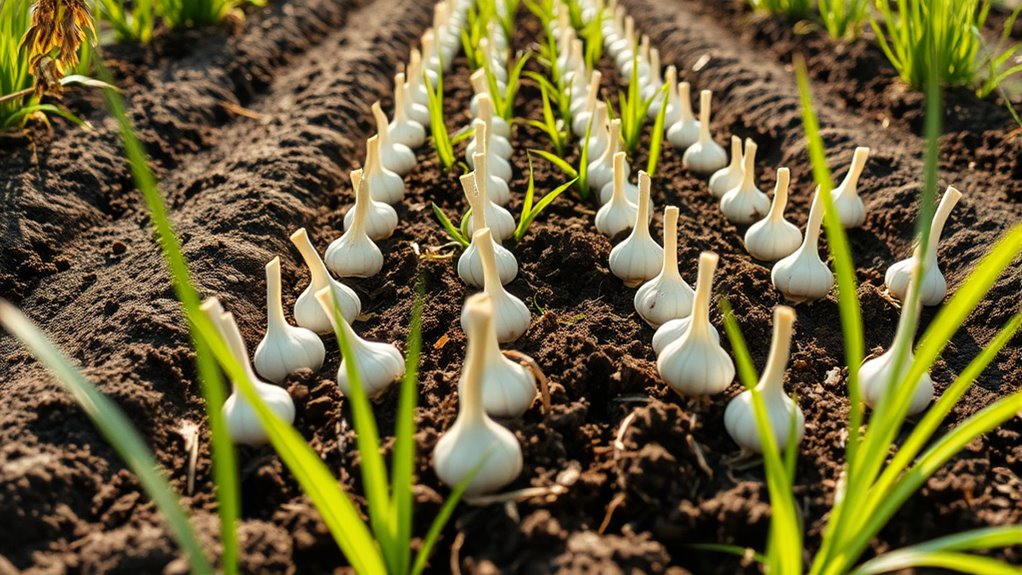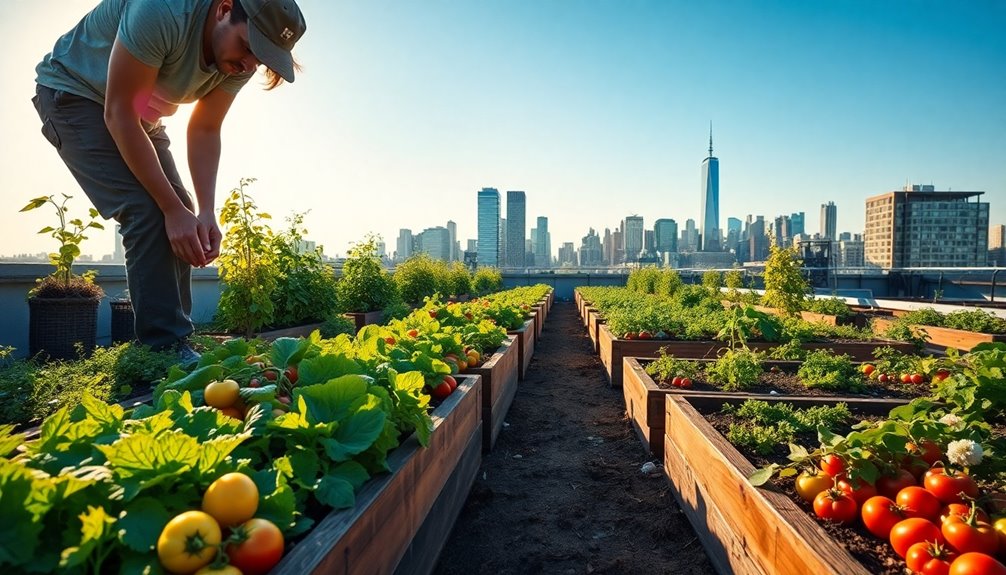In early September, start by clearing your garlic bed of debris, weeds, and old plant material to prevent pests and diseases. Consider adding compost and organic amendments after testing your soil to boost nutrients. Level the soil surface and lay mulch like straw or shredded leaves to suppress weeds and retain moisture. Carefully select healthy garlic cloves, plant them pointed end up, and space them well. To learn more about preparing for a healthy garlic harvest, keep exploring these tips.
Key Takeaways
- Clear debris, weeds, and old plant material to prevent pests and diseases before planting.
- Conduct soil testing and amend with compost or organic nutrients to optimize fertility.
- Level the soil surface and apply mulch to suppress weeds and retain moisture.
- Select healthy garlic cloves suited to your climate and plant them 2 inches deep, spaced adequately.
- Establish a maintenance routine with regular watering, compost tea, and pest barriers to support healthy growth.
Assessing and Clearing the Bed
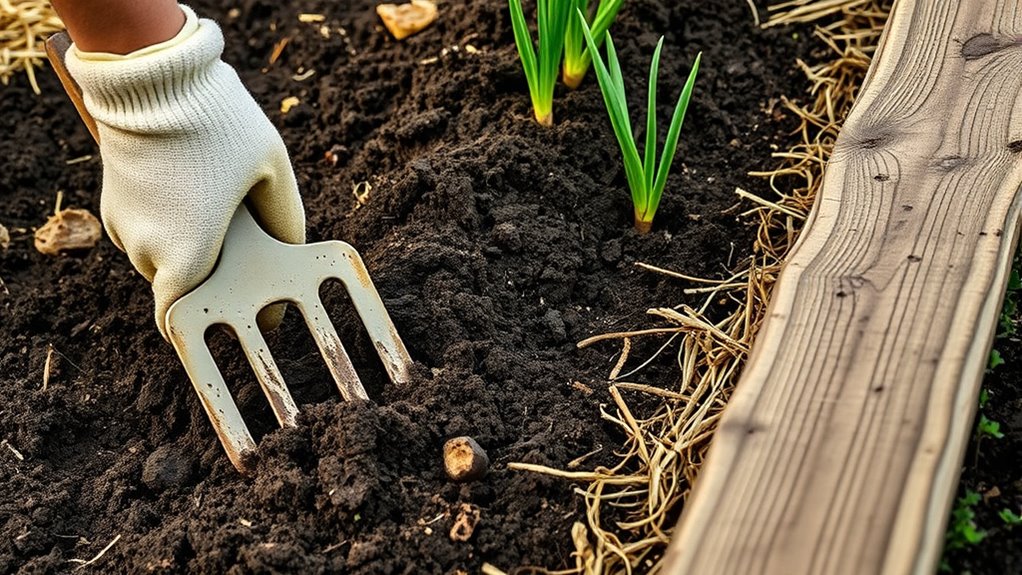
Before you begin preparing your garlic bed, it’s important to assess and clear the area thoroughly. Check for any debris, weeds, or old plant material that could harbor pests or diseases. Removing these helps prevent pest infestations and encourages healthy garlic growth. Consider mulch options now; a layer of straw or shredded leaves can suppress weeds and improve moisture retention. However, avoid thick mulch layers that may trap pests or promote rot. Inspect the soil for signs of pest activity or damage, and remove affected plants or materials. Clearing the area also gives you a clear view of the bed’s condition, making it easier to spot potential issues early. Proper assessment and cleaning set the foundation for a healthy garlic crop and effective pest control throughout the season. Additionally, incorporating portable camping gear such as lightweight tools can make the process more efficient and comfortable.
Amending the Soil for Optimal Growth
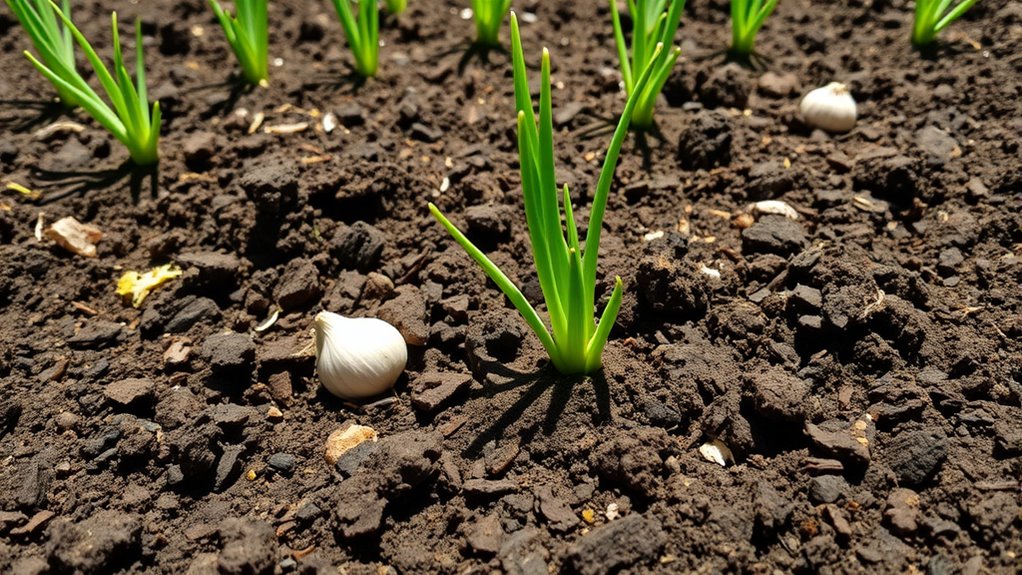
After clearing your garlic bed, it’s time to amend the soil to create the best environment for healthy growth. Start with soil testing to determine nutrient levels and pH. Based on the results, you can adjust accordingly. Incorporate compost application to boost organic matter and improve soil structure. This helps retain moisture and provides essential nutrients. This process aligns with soil health practices that support sustainable gardening. Consider adding balanced organic amendments if tests reveal deficiencies. To ensure even distribution, mix amendments thoroughly into the soil. Keep in mind that well-amended soil promotes stronger garlic bulbs and prevents diseases. Proper soil preparation now sets the stage for a successful garlic harvest later. Utilizing seasonal soil management practices can further optimize soil health and plant development. Paying attention to soil pH adjustments can enhance nutrient availability for optimal plant health. Additionally, observing plant response to amendments can help fine-tune your soil management strategy.
Preparing the Bed Surface and Layout

Preparing the bed surface and layout is a crucial step to guarantee your garlic plants have a stable foundation. Start by leveling the soil surface to prevent water runoff and ensure even moisture. Apply mulching techniques, such as straw or shredded leaves, to suppress weeds, retain soil moisture, and regulate temperature. This creates a consistent environment for garlic growth. Consider your layout carefully—space cloves evenly to promote airflow and reduce disease risk. Incorporate pest control methods by removing debris and avoiding overcrowding, which can harbor pests and diseases. You might also use organic barriers or companion plants to deter pests naturally. Proper surface preparation and thoughtful layout set the stage for healthy garlic development, making your subsequent planting more successful. Additionally, choosing a hybrid versatile bike can make transporting supplies or navigating your garden more efficient and comfortable. Ensuring your soil has the right nutrients can further enhance garlic growth and yield. Maintaining soil health through proper preparation supports vigorous garlic development and long-term garden productivity, especially by integrating soil amendments to boost fertility.
Selecting and Planting Garlic Cloves
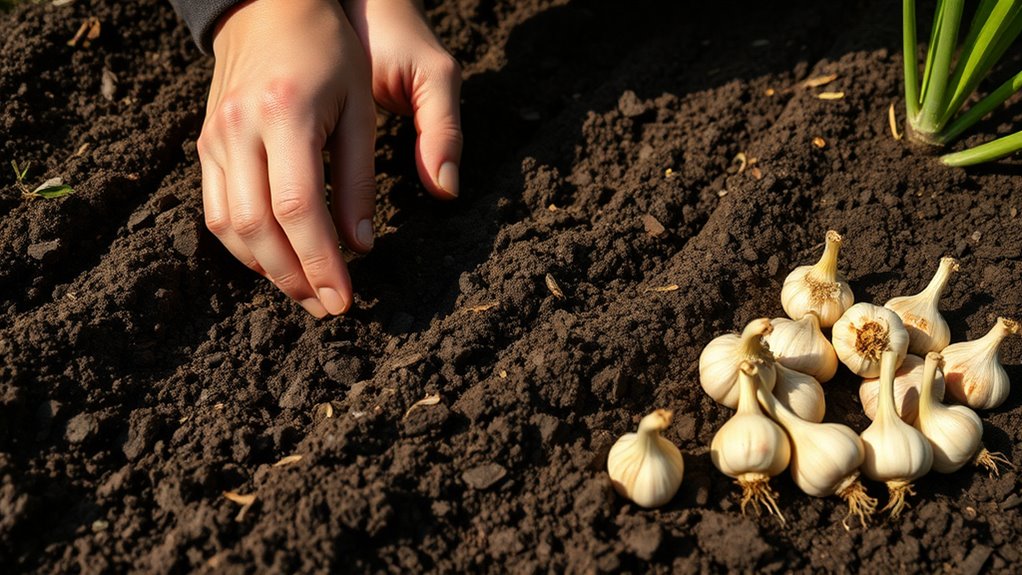
Choosing high-quality garlic cloves is essential for a successful harvest. Select healthy, firm cloves free of mold or damage, and consider different garlic varieties to suit your climate and flavor preference. When planting, aim for the correct planting depth—usually about 2 inches deep—to protect the cloves and encourage strong roots. Incorporating vintage decor elements can also inspire a natural and timeless aesthetic in your garden setup. Here are key tips:
- Choose large, plump cloves for better yields
- Pick garlic varieties suited to your growing zone
- Plant cloves with the pointed end facing up
- Maintain the proper planting depth of around 2 inches
Proper selection and planting depth help garlic develop healthy bulbs. Handle the cloves carefully, and space them adequately to ensure good airflow and growth.
Establishing a Maintenance Routine
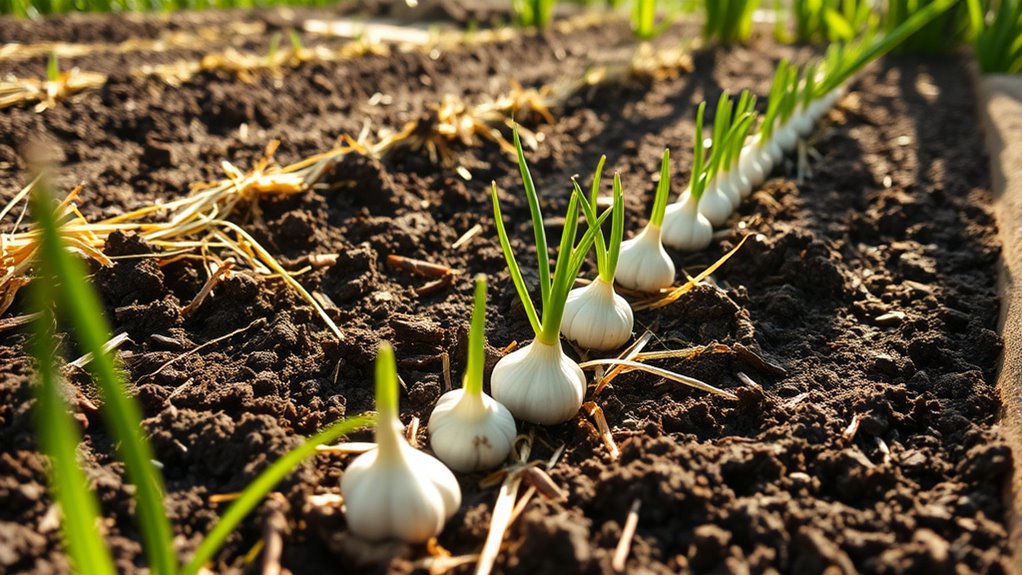
Once your garlic is planted properly, establishing a consistent maintenance routine guarantees healthy growth and a bountiful harvest. Regular care includes watering, applying compost tea, and monitoring for pests. Using pest barriers helps keep away critters that can damage your garlic, while compost tea boosts soil nutrients and plant vigor. Developing a schedule to check on your garlic every 7-10 days ensures that you can promptly address any issues that arise. Incorporating proper watering techniques helps prevent overwatering or underwatering, which can stress your plants. Mulching helps retain moisture and suppress weeds. Additionally, maintaining soil health through organic amendments promotes robust garlic development. Staying attentive to pest management strategies can further protect your crop from potential damage. Here’s a simple overview:
| Task | Frequency | Purpose |
|---|---|---|
| Watering | Weekly or as needed | Keep soil moist |
| Pest Barriers | Continuous | Prevent pest damage |
| Compost Tea | Every 2-3 weeks | Boost plant health |
Stick to this routine, and your garlic will thrive. Incorporating aesthetic wall organization ideas can help create a tidy outdoor space that facilitates easy maintenance.
Frequently Asked Questions
When Is the Ideal Planting Date for Garlic in Early September?
Plant garlic in early September if you want a fall planting, which allows the cloves to establish roots before winter. This timing is ideal for better garlic storage and larger bulbs at harvest. Use proper garlic harvesting techniques to guarantee healthy bulbs, and store your garlic in a cool, dry place after harvesting. Planting early helps you enjoy fresh garlic longer and improves your overall yield for the season.
How Do I Prevent Pests and Diseases in Garlic Beds?
Ever wonder how to keep your garlic healthy and vibrant? You can prevent pests and diseases by implementing effective pest control strategies and disease prevention methods. Regularly inspect your beds for signs of trouble, use organic mulches to deter pests, and rotate crops annually to break disease cycles. Keep your soil well-drained and avoid overwatering. These proactive steps help safeguard your garlic, ensuring a robust, flavorful harvest.
What Are the Best Garlic Varieties for My Climate?
You should choose garlic varieties suited to your climate for the best results. Consider flavor profiles that match your taste preferences, whether you want mild or robust garlic. Look for varieties that store well, following garlic storage tips like curing properly and keeping them in a cool, dry place. Selecting the right climate-adapted variety guarantees healthy growth, better flavor, and longer storage, making your garlic harvest more satisfying.
How Deep Should I Plant Garlic Cloves?
Think of planting garlic like planting a tiny forest; you want it just right. You should plant cloves about 2 inches deep, ensuring soil moisture stays consistent. Proper garlic spacing—around 4-6 inches apart—helps prevent overcrowding, allowing roots to develop freely. If you plant too shallow or too deep, your garlic might struggle, but with the right depth and spacing, you’ll set the stage for healthy, robust bulbs.
Can I Plant Garlic in Containers Instead of the Ground?
Yes, you can plant garlic in containers instead of the ground. Container gardening is a great option, especially if space is limited. Make sure to use well-draining soil and prepare it properly by mixing in compost for nutrients. Choose a container at least 8 inches deep, with drainage holes, to give your garlic enough room to grow. Regular watering and proper soil preparation will lead to healthy, flavorful garlic.
Conclusion
By beginning your garlic bed prep with careful clearing, creative cultivation, and consistent care, you set the stage for a successful season. Remember, a well-worn routine results in wonderful, healthy bulbs. Stay steadfast in your soil’s service, and your garlic will grow strong and splendid. With patience and persistence, you’ll produce plenty of plump, pungent cloves—proving that preparation paves the path to produce perfect produce. Keep cultivating with confidence, and enjoy the rewarding results!

